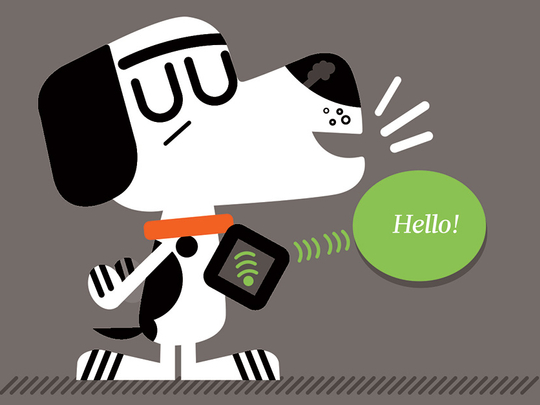
On April 1, 2010, Google announced a breakthrough for the animal kingdom: an Android App that would allow an impressive range of species, from guinea pig to tortoise, to speak in English. The date was, naturally, significant. Presumably the advertised “animal linguistic database”, against which the “neurobiological acoustics” of the animal’s utterances would be compared, never existed. The “tortoise” file would have been pretty limited, in any case.
Now, the idea of talking animals has resurfaced as part of Amazon’s ‘Shop The Future’ concept, but this time it seems more serious. It’s mainly focused on dogs, though in principle it could be adapted for other domestic animals like cats — maybe even tortoises. The core of the technology would be a collar that monitors precisely how the animal is moving. When it recognises from those movements that the animal wants something, the “speaking” part of the collar activates. For example, when the dog scratches at the back door, the collar might say “I need to go out!”. The speech part of the collar can be programmed to speak in the owner’s interpretation of their pet’s “voice” — which should incidentally provide scope for all manner of humour, both intended and unintended.
Amazon also suggests that the collar might “translate” barks into English, coming close to Google’s tongue-in-cheek claim of converting “animal speech into human vernacular”, but there seems little point — the dog’s bark would most likely drown out the voice coming from the collar. There might also be some technical obstacles in getting the collar to recognise specific elements of each dog’s body-language, since dogs come in such a wide variety of shapes, sizes — and energies. Imagine a collar designed for a Saint Bernard being accidentally swapped for one intended for a border collie.
Although Amazon’s intentions in announcing such a product may have been more headline-grabbing than thought-through, they do raise the more serious issue of how well we communicate with our pets. Despite all the time pressures imposed by modern lifestyles, many of us still desire to include pets in our families. Learning to understand a new dog takes time, but many new owners seem woefully unprepared for this, doing no research into what dogs’ needs are before buying one, often via the internet. The current craze for flat-faced dogs such as pugs and French bulldogs, many of which suffer debilitating and painful genetic disorders as they age, is just one consequence of this lack of forethought.
Pet owners undoubtedly want to do the best for their animal companions, but there is still widespread misapprehension of what their pets are actually thinking and feeling, moment-to-moment. The majority of cat owners believe that their cats can feel pride, but biologists consider this complex emotion to be beyond the capabilities of the feline (or canine) brain. Likewise, it’s easy to fall into the trap of assuming that a dog is feeling guilty when we discover that it’s chewed up the TV remote when our backs were turned, but again, there’s no scientific evidence to back this up.
When psychologist Alexandra Horowitz tricked owners into believing that their dogs had disobeyed them while they were out of the room, the dogs immediately went into full-blown “guilty” mode; evidently they were reacting to subtle cues in the owners’ body-language that informed them that a scolding was imminent.
Misreading of a dog’s feelings and intentions can have serious consequences. Much attention has been given to so-called “dangerous” dogs, especially when one attacks an innocent passer-by, but what the headlines obscure is that many of the most serious attacks are by family dogs on the children they live with (and few of these involve pit bulls or other banned breeds). Parents have the responsibility to ensure that their dog is trained to behave appropriately around children, and likewise to teach their children the right way to approach a dog.
From the dog’s perspective, the most useful technology might be one which recorded their feelings not when their owners were nearby, but when they weren’t. Every day, millions of dogs are left alone while their owners go out to work: most of them hate being left alone (and contrary to a common myth, the company of another dog is no substitute). Some bark, some howl, some pace around; some simply lie down and appear to rest, but their skyrocketing stress hormones betray their anxiety. Only those that distract themselves by pawing a hole in the door or burying themselves under the sofa cushions, or lose control of their bladder or bowels, alert their owners to their distress — and even this is often misinterpreted as “boredom” or even “spite”. Dogs can be trained to cope with being left alone, but few owners are aware that they can (indeed, should) do this. For those who accept this responsibility, technology that reassured them that they were succeeding would be a boon.
For those technophiles who desire a mess-free “animal companion”, realistic robot pets are probably a better solution than a living, breathing, pooping animal, however technology-equipped. Sony may have pulled the plug on its unprofitable Aibo ‘dog’, but Paro, a robotic “seal pup”, has proved highly effective in alleviating anxiety and depression in dementia sufferers — and even at $6,000 each, they’re cheaper than a lifetime’s bills for a pug.
— Guardian News & Media Ltd
John Bradshaw is an honorary research fellow at the University of Bristol’s vet school and author.









